Ruth Badley's Blog
August 31, 2025
Message from the Author
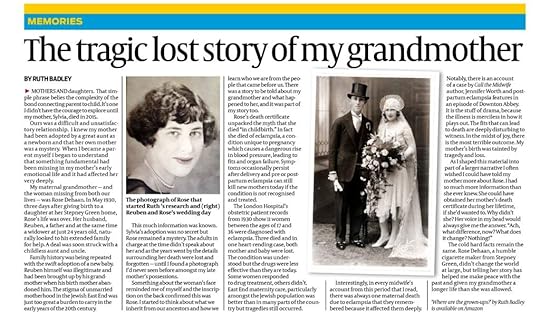
This is a heartfelt message of thanks to all the readers who have taken the time to read Where are the grown-ups in the last couple of months, to leave a review on Goodreads and to follow me for further updates. It is so encouraging to receive reader feedback which indicates my very personal story resonates with others. That was exactly my intention. While the impact is still fresh in your mind I would be so grateful if you could recommend Where are the grown-ups to a few readers who would be happy to purchase a copy in either ebook, paperback or audio format. I narrate the audio book myself.
I am genuinely thrilled by reader responses from book club members but authors receive nothing when multiple free review copies are distributed and this is very discouraging for writers who hope that putting their heart and soul into their work will occasionally yield a small royalty payment.
If you enjoy my writing you may like to know I have written a travel memoir called Bite-sized World. There is some overlap with Where are the grown-ups in a chapter on Lebanon which I wrote shortly after my mother, Sylvia died.
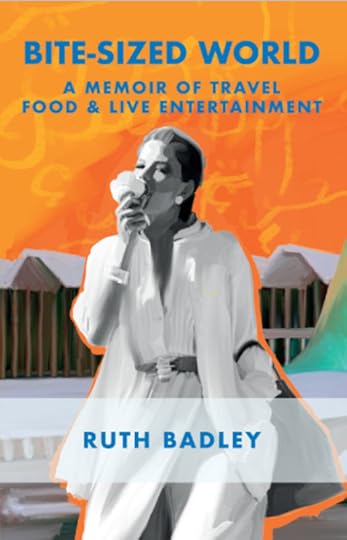
I am currently working on my third book but I am at a crossroads in my writing career as without sales, my ambitions are not sustainable. Please do share this information to support a hard-working author and Happy Reading!
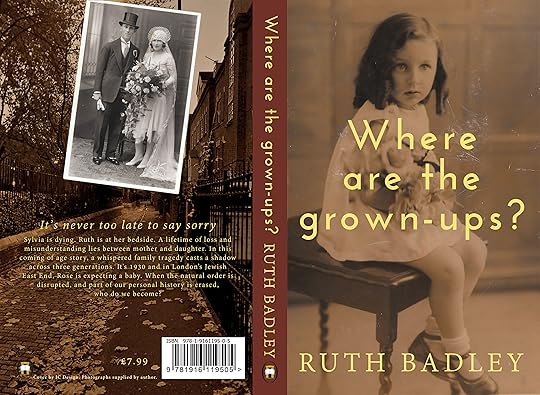
January 10, 2025
Temples and Gardens in Chiang Mai

Chiang Mai can rightly claim to be the city of temples. There are 300 Buddhist temples in total and most are located within the historic centre, where the ancient city walls and moat were originally built in the 13th century as protection against the marauding Burmese armies. A stroll through the Old Town and the scale, decorative opulence and symbolism of the religious structures is soon apparent.
By happy chance our hotel was located opposite, Wat Chedi Luang one of the most important and busy sites in Chiang Mai. The whole complex comprises several buildings of historical and religious significance, plus a university and shrines to faith leaders containing relics and disturbingly realistic wax figures of revered monks and abbots. Throughout the grounds tourist groups, monks in their orange robes, guides and devotees rub shoulders daily. This may be an ancient site but it is also an essential part of daily life for local worshippers. There is a tangible feeling here of calm, generosity and respect.
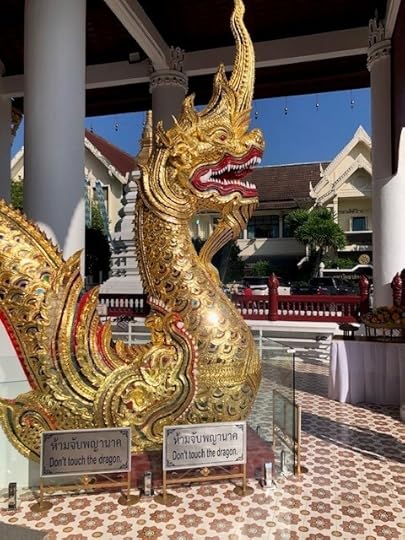
Phra Viharn Luang is the main prayer hall, directly behind the front gates. Shoes are left outside and visitors are advised to step over the threshold, not on it, and for shoulders and bare legs to be covered. Inside there is much to learn from the devout, and so many features to look at. Although some date from the 14th century the actual building has been reconstructed many times, most recently in 1929. Aside from the altar where a giant, gleaming bronze Buddha and his two smaller shining disciples are the focal point, there are stately columns with golden decorations, beautiful murals on the window and door shutters and many hanging symbols to bring good luck and prosperity.
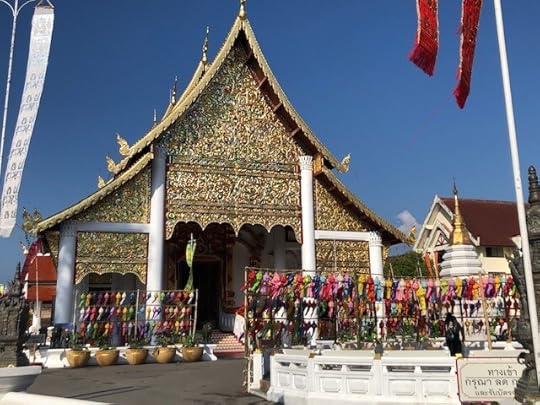
On one side of the hall there are seven bronze Buddhas one for each day of the week, positioned above collection boxes. In Buddhism, the day and year of an individual’s birth connects to their character and lucky colour, similar to the Chinese zodiac system. Google can calculate all this information from the date and year of birth. A guide on the site did this for me. Apparently I was born on a Wednesday in the Year of the Rabbit and my colour is green. Armed with this information I found the particular box for my day of birth and made a small donation. I could then take one of the square packets of thin gold leaf provided and carefully press this onto the statue, as one of the worshippers kindly demonstrated for me. There’s certainly many opportunities throughout this complex to give money as an insurance for the next life and hopefully assist the poor that need help with their current one.

Adjacent to the prayer hall is a smaller building housing the City Pillar, a sacred object, associated with the founding of Chiang Mai, and believed to provide stability and fertility to the population. The building contains beautiful murals and another golden Buddha but as women are not allowed to enter, I can’t claim to have seen them! Behind the prayer hall is the Grand Stupa – an enormous 60-metre-high Buddhist monument dating from the 14th century with an array of amazing carvings and elephant sculptures on all four sides. Restoration work undertaken in the 20th century has partially repaired damage caused by an earthquake.
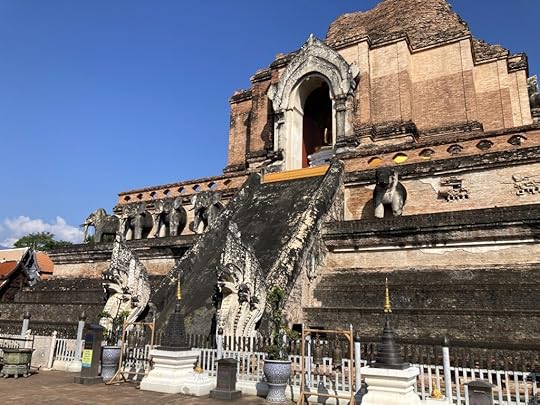
It takes a good couple of hours to visit all the different buildings and collections on this site but one of the most surprising experiences comes at the end when visitors are invited to chat to a monk to find out a little more about their lifestyle and beliefs. The young men most eager to talk are studying English at the university. It amused me that they had iphones. These days, one told us, it was no longer compulsory for boys under 20 to become novice monks for a short period of time as in the past. Mod, aged 25, and the chattiest one of the group, told us he wasn’t too fussed about Buddhism but being a monk offered a cheaper route to university. He was keen to know what advice we would give him about living in London! He had come to Chiang Mai to study as the civil war in his native Myanmar had cut short his education. He seemed remarkably streetwise and very proficient in spoken English, and I reckon he would do just fine in London provided he had some warmer clothing.
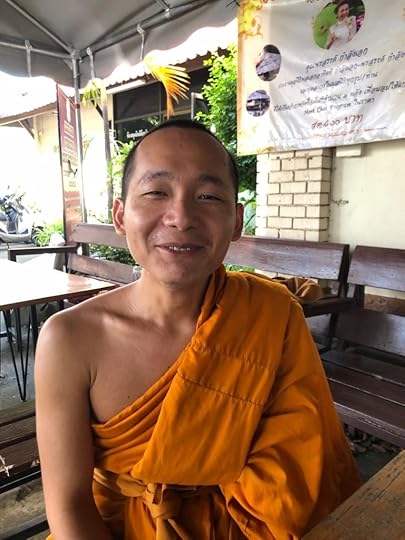
Coffee culture in Chiang Mai is thriving and the city is awash with hipster cafes serving brews from crops grown in the region. Replacing opium cultivation with coffee was an initiative started by the previous Thai king and the crop now provides growers with a sustainable living and improved living conditions in agricultural communities. One of the quirkier places to enjoy a cup of local coffee is Chom Café and Restaurant, just a short drive from Chiang Mai. We had hired a driver to take us to the Botanic Gardens in the National Park and arranged a couple of stops on the way. The café was just opening up and we were the first customers of the day, but the atmosphere was already steamy. We appeared to be in a rain forest garden complete with lush vegetation, mists, exotic flowers, bridges and waterfalls!

The design and layout was extraordinarily detailed, the sight and sound of moving water was everywhere and the landscape intriguing. As we explored all the walkways and hidden routes we wondered if the forest planting was actually living and growing. Everything had such a dream-like quality to it that you felt you had to touch the plants to be sure they were real.

From a man-made rain forest to the real thing, as the next stop was Mae Sa Falls Forest Park. A series of walking trails and viewing platforms on ascending levels allow visitors to safely appreciate the beauty of the waterfall as it cascades in ten tiers. In the weeks before our visit this area had suffered from rainy season flooding and access to the higher levels was restricted for safety reasons. Nevertheless, it was still a beautiful place for a brief stop and some forest air.
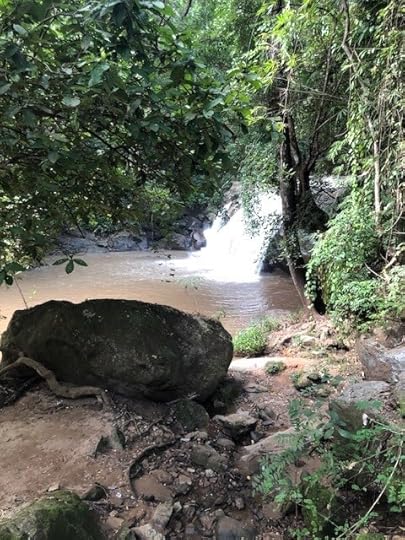
Our final stop was the Queen Sirkit Botanic Gardens, an enormous area dedicated to botanical study and research as well as being a visitor attraction. We started with spectacular panoramic views of the mountains and the gardens from the Canopy Walkway, a 400-metre-long path, suspended above the treetops with glass bottomed viewing areas for extra thrills.

It’s impossible to see everything in one visit so we spent a relaxing hour or so wandering in and out of the themed glasshouses, admiring the succulents, and the native flora. My takeaway from the displays? The Hmong Hill Tribes in Thailand use aromatic plants to flavour their favourite chicken soup and give it medicinal properties. We didn’t get as far as visiting a Hmong village on this trip but that fact about their culture I find very endearing.

December 14, 2024
Culture and Food in Chiang Mai
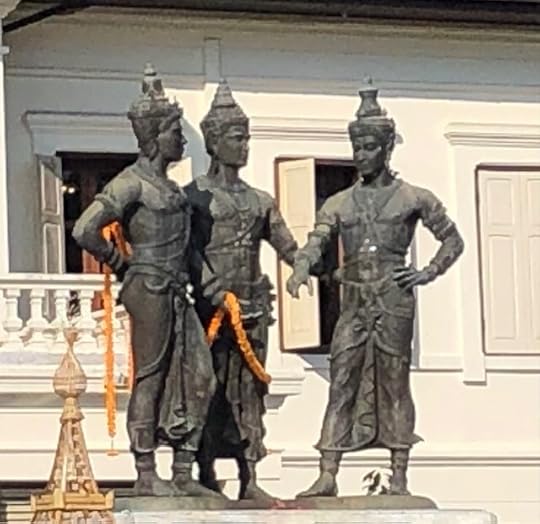
Chiang Mai, the largest city in Northern Thailand was established in 1296 as the capital of the Lanna Kingdom. The Three Kings sculpture in the historical centre is a landmark monument and tribute to the founding fathers of the city but it was not exactly a peaceful start. The Kingdom came under repeated attack from Burma (now Myanmar) to the north and Siam in the south for several centuries. The ancient city walls and moat speak to this long struggle. In 1557 the Burmese were victorious and ruled for 200 years until the Lanna King joined forces with Siam to finally drive the Burmese out. The Kingdom’s territory was subsequently greatly reduced and incorporated into Siam in 1892. Chiang Mai and the surrounding area was eventually made a province of the country, renamed as Thailand in 1949.
In this culture members of the Royal family, past and present are universally revered by their subjects and cultural etiquette around the Monarchy is strictly observed. For example, it is a criminal offence to speak disrespectfully of the Royal family or to be perceived to be abusing their images by licking stamps in public or stepping on a dropped coin in the street. Whenever I think of Siam, it is the depiction by Yul Brynner of the fierce King Mongkut in Rogers and Hammerstein’s musical The King and I that springs to mind. Not surprising then that this material, based on the memoirs of Anna Leonowens, governess to the King’s children in the 1860s remains deeply insulting and is banned in Thailand.

While the Royals may be worshipped they are not as remote from ordinary people’s struggles as you might think. HM Princess Bajrakitiyabha Mahidol has spearheaded an inspirational prisoner rehabilitation programme in Chiang Mai that is changing women’s lives for the better. The female prison population went up by 50% between 2006 and 2012 with money laundering and drug-related crime the main offences. In many cases debt, driven by poverty played a part. With the stigma of a prison sentence affecting future job prospects a cycle of reoffending was inevitable. To counter this, a day release programme for the inmates of Chiang Mai’s Women’s Correctional Institution allows them to train and practice in the massage and catering industries during the day and return to prison at night until their sentence is served. The skills they acquire means they have a direct route to employment on release and can forge a new and better path in life. It’s a virtuous circle that tourists can and do support and it’s brilliant.
Once we learned about the concept we were regulars at the outdoor coffee shop and restaurant, adjacent to the women’s prison. Massage services were so popular there that I couldn’t get an appointment at this outlet but another one nearby, run by former inmates obliged. My feet were grateful.
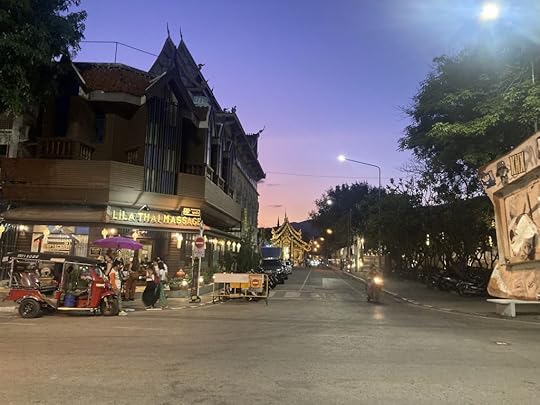
It’s hard to believe that these charming, young women have done anything criminal as they bring you coffee, prepare delicately flavoured coconut pancakes or knead your aching muscles with tiger balm. Respectful behaviour is deeply ingrained in Thai culture and for visitors this is apparent in the traditional greeting, experienced many times a day on entering shops, restaurants and hotels – palms pressed together, fingertips level with the nose, a slight bow of the head, a smile and a softy spoken Sawadee kha. No wonder Thailand is known as the land of smiles.
Always hungry
The Thais love their street food and snacks are available on every corner, from individual sellers with rickety little stalls to open shop fronts. When the heat is on, chunks of fresh mango, pineapple, dragon fruit, some with white flesh and black seeds, another variety, leaking beetroot-red juice hits the spot. To start the day, crunchy guava, sweet papaya, and thirst-quenching watermelon were always available during our visit in November. More filling and completely delicious were the little parcels of sweet potato or banana, wrapped in banana leaves and grilled till soft and sweet.

A particular favourite are Kanom Krok – tiny hemi-spherical coconut pancakes, briefly mentioned above. These are cooked in a special pan to create individual crispy shells with a sweet custard-like centre. Finished with more coconut, tiny pieces of corn or green onion, these are a moreish blend of sweet and savoury.
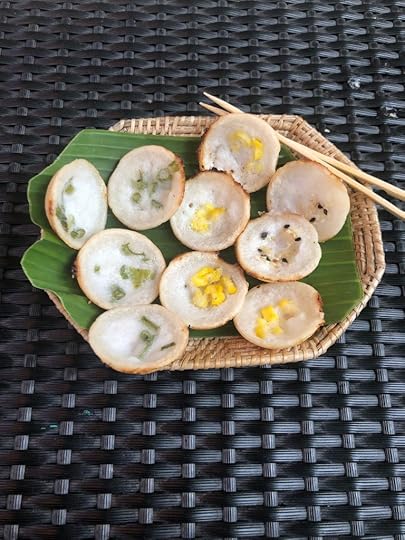
One of our first restaurant experiences was at Paak Dang, a gorgeous teak building and riverside setting providing employment and hospitality training for vulnerable young people. Miang Kham Goong another popular Thai snack was on their list of starters, but I needed a bit of coaching on how to eat it. Many years ago, in Singapore I was served a dish of steamed chicken, wrapped in a pyramid of bamboo leaves. In my ignorance I assumed it was all edible. To a panda, it probably is, but luckily the waitress put me straight before I did myself an injury. The memory of that blunder has never left me, so I tend to approach food wrapped in leaves with trepidation.
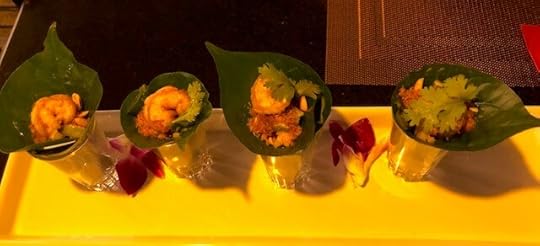
Our grilled fresh prawns arrived wrapped in betel leaves, beautifully arranged in a row of shot glasses. I’m glad we were advised to eat the whole thing before I deconstructed it. As well as a burst of ginger, lime and shallots, our juicy sweet prawns were bathed in a toasted coconut dressing, and the betel leaves holding it all together added a fresh crunch of green goodness.
We stumbled across Lemongrass restaurant, tucked away on a back street. Not at all fancy but here we shared a very fine whole steamed fish, with fried rice piled high into half a pineapple, flecked with tiny pieces of the fruit, peanut crumbs, and red pepper for colour. The fish, served on a platter of banana leaves had been cleverly boned and portioned in great white flakes for the table, but somehow retained its original shape.

Chiang Mai’s Finest Dish
Before we flew to Chiang Mai we did some research on the typical dishes found in Northern Thailand. We’d heard that the red and green curries that we know and love are particular to the south and that Chiang Mai has its own specialities. It doesn’t matter where you go in the world you can be sure that someone has been there, checked it all out and stuck a video on the internet for your reference. There’s a guy on YouTube that travels everywhere, eats everything, and is universally impressed by it all. Given his consistent enthusiasm it is easy to identify the foods that don’t align with your tastes and more importantly the dishes that make your mouth water in anticipation. The videos he offers on eating in Chiang Mai are typical of his informative style. The dubious looking pork sausage dipped in chilli paste he consumes with obvious relish and the obligatory ‘wow’ at first bite, is not a combination I find at all tempting. This is Sai Ua and was one of many dishes available at our hotel for breakfast. I tried a tiny sample. It’s seriously hard core.
Khao Soi, on the other hand is a crowd pleaser and as soon as you land in Chiang Mai, everyone will tell you where to eat it. Our friend from the internet found his favourite version amongst the hill tribes outside the city. On the way from the airport, unbidden our taxi driver pointed out his favourite place, while a tour guide, argued the best version was served somewhere else entirely. It’s THE dish of Chiang Mai. A bowl of soft egg noodles, with either beef or chicken in a rich coconut curry broth, topped with crispy noodles for texture and Thai basil or coriander. It’s Burmese influenced, flavourful, comforting and without a strident chilli heat. The diner can customise their bowl to their own taste with accompanying chilli flakes, wedges of lime, sliced shallots, pickled greens and sometimes, sugar.
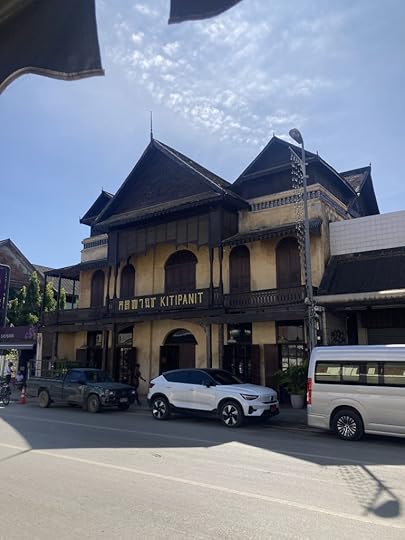
In just a week my research was necessarily limited but even in that short time I can confidently point to my favourite place to eat Khao Soi. The best version of this dish, in my opinion, is with beef. The chicken version features a whole leg plonked in the bowl which is awkward to eat and does not soak up the flavours of the broth in the same way as slow cooked cubes of beef that collapse into tasty strands with a mere touch of the fork. Slices of beef will not do either as they cook too quickly to take on all the complexity of the flavourings and risk being chewy. Khao Soi simmered beef perfection is to be had at Kiti Panit, a restaurant in a sprawling mansion, dating back to the 1880s when the building was a general store, selling fancy imported goods. Photographs, teak wood and antiques preserve the heritage and add to the dining experience.
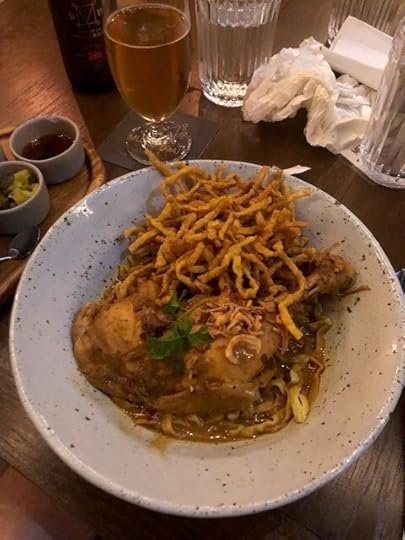

Our first visit nearly ended in disaster because we hadn’t booked and this place is very popular. After receiving the bad news that the place was full we stood outside, unsure how our evening would turn out. Clearly moved, by our disappointed faces, the manager had somehow created another table and came running after us just as we moved off into the night. We were treated to our own space in the quieter outdoor dining area behind the main dining hall. Brilliant service. Faultless cooking. Still thinking about that wonderful Khao Soi!
Coming soon, Chiang Mai’s Temples and Gardens
December 3, 2024
Celebration time – November 2024 in Chiang Mai
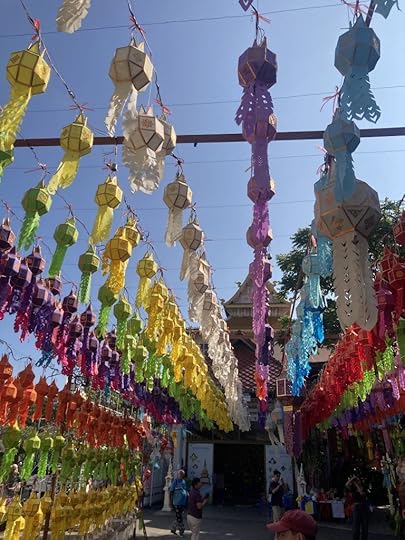
In the same month that Donald Trump is elected the 47th President of the United States, the biggest city in Northern Thailand is unperturbed. Despite the global shock waves reverberating at what the result might herald, Chiang Mai’s attention is calmly focussed on loftier matters and ancient traditions. I’m reminded of a former First Lady’s apt wisdom. ‘When they go low, we go high.’ For here in Buddhist Chiang Mai, going high is what it’s all about. We’ve heard that come full moon in the 12th month of the Thai lunar calendar, thousands of paper lanterns are released in spectacular style into the night sky. We’ve come here specifically to witness this spiritual event because it takes place at the same time as a personal milestone ‘0’ birthday that needs to be marked in memorable fashion, and in a warmer climate than the UK. For as the lanterns float skywards, powered by fire, they symbolise the release of misfortunes and hopes for the future. Amen to that, eh?
As we arrive preparations for the approaching Yi Peng festival are well underway in the Old Town with strings of decorative lanterns in rainbow colours visible along the streets, temples and outside every shop and restaurant. The lantern festival is a religious and cultural event unique to Chiang Mai, cleverly marketed to attract visitors. Loy Krathong, the other celebration taking place in the same week at riversides and waterways across Thailand is a much older tradition honouring the goddess of water and Buddha.
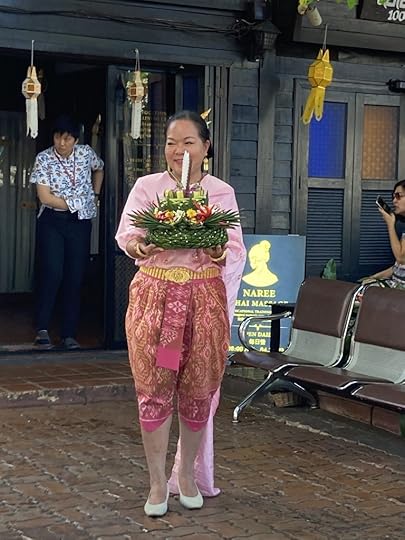
A Krathong is a handmade flower arrangement, designed to float on water. The colourful decoration features a slice of trunk and the leaves from a banana tree, lotus flowers, marigolds and orchids, plus a candle and incense sticks. The whole thing is remarkably robust and as the event day draws close hundreds of these home crafted items appear for sale on street corners and market stalls, priced at less than £1. A tiny price considering the obvious care taken and the impact they create when the candles are lit and the little rafts are afloat. In several locations during the day we see women being photographed in traditional outfits, proudly holding their more elaborately fashioned krathongs in readiness for a parade through town ahead of the riverside ceremony. More of this later. First there are lanterns to launch.
In recent years the lantern festival has attracted criticism for the negative environmental impact created by a mass of non-biodegradable materials endangering wildlife when they land in fields and waterways. It seems such issues are largely overlooked by visitors and locals caught up in the romance of the moment, but it is strictly forbidden to release lanterns within the city as they pose an understandable hazard to aircraft. For this reason, designated outdoor locations on the outskirts of Chiang Mai host the festival on two consecutive nights. The exact arrangements seem a little vague, but it turns out participants need to purchase tickets from an authorized travel agent and all will be revealed.
Up, Up and Away
We’ve left it late to secure our places but as we climb aboard one of a convoy of coaches heading to Doi Saket, a town 25km from Chiang Mai, we conclude that the £60 cost per ticket is probably going to be worth it for the transport there and back alone. Lanterns are provided at the destination and apparently a meal too. This was seriously undersold. We expected a few snacks in a box but as we arrive the organisers are putting the final touches to a self-service hot buffet with an array of food and drink for the thousands of hungry visitors pouring in. Initially it seems like chaos but miraculously everyone is being amply fed and watered. There is no rush or panic, despite the enormous number of expectant people. When an announcer tells the throng that a mass lift off is planned for 7.30pm it’s our cue to collect our lanterns and find a suitable spot on the lakeside bank for a practice launch. Our ticket entitles us to eight lanterns in total so by the size of these things there is clearly a technique to master that will require two pairs of hands and several practice runs.
Hundreds of people of all ages are trying to find a firm footing on the steep bank, with enough space to safely unfurl their rice paper lanterns and set light to the square of wax inside. Eventually we find a suitable spot and like some sort of magic trick an elderly Thai couple appear beside us to show us the ropes. Success requires patience as the wax takes a while to fully ignite and then you have to allow the flame to generate enough hot air to lift the lantern out of your outstretched arms. Relax your hold too soon, the lantern will sink, and you risk saying goodbye to your eyebrows. It takes a few goes to feel the satisfying pull that indicates you can safely let go and follow your lantern’s twinkling journey to join the rest against the night sky. In the excitement and beauty of the spectacle I forgot all about making a wish. Frankly, it was enough for me that I didn’t set myself or anyone else alight.
The countryside in Northern Thailand must be littered with metal rods and burnt blocks of wax in the aftermath of all those lanterns falling to earth so the environmentalists certainly have a point. Perhaps next year the materials used could allay those concerns. I should have made that my wish. This extraordinary public event also involved fireworks, but the obvious health and safety concerns that would have prevented this kind of event back home don’t materialise here. People just behave well!

In addition to the lanterns, we were gifted two krathongs so the following evening we head towards the River Ping, first to watch numerous costumed community groups and marching bands parade by before joining the crowds at the riverside. It is time for the ritual letting go of all misfortune and the welcoming in of a year of positivity and good fortune by lighting and setting these little decorations free on the water.

Again, there is help on hand to assist a never-ending stream of people crammed onto a bamboo pontoon, krathongs in hand. Two Thai gents, standing waist deep in the river for the entire night are tasked with lighting the candles and incense sticks and making sure the craft sail down the river as the occasion demands. It’s a beautiful couple of days in the Thai calendar and I’m thrilled to have participated.
Coming soon, Chiang Mai’s Temples, Culture and Food.
October 30, 2024
Ljubljana – the cutest, most compact capital in Europe
Foreigners Everywhere Part 4
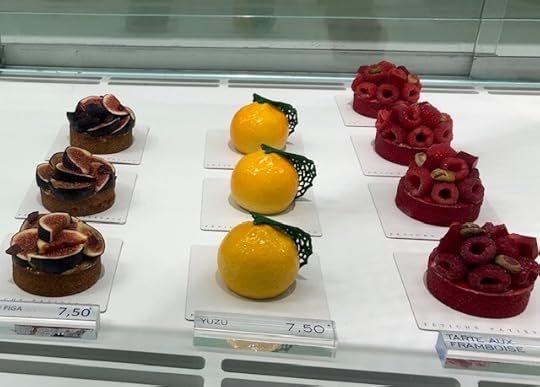
London, Paris, New York … Ljubljana? I love capital cities for all the sprawl, noise and attention that the world’s greatest examples demand. Slovenia’s capital and the last stop on our trip couldn’t be more different to those big beasts. Ljubljana is one of Europe’s most environmentally friendly cities and with a population of only 300,000 it feels more like a town than the political, administrative, cultural and economic centre of the country. The Slovenians are a rare breed as the entire population numbers only two million in a country that is more than 60% forest.
Old Town Ljubljana is compact, historical and pleasantly walkable with pedestrians and cyclists prioritised. The most congested traffic we encountered was at the city’s bus station, a hub for student travellers making the most of their freedom before the start of the university term. In Slovenia, as we found in Italy, public transport is both reasonably priced and reliable compared to the UK. Witness our experience in arriving here.
A relaxing train journey of about two and half hours from Trieste is interrupted by an agitated guard running to and fro, an inaudible announcement and a long stop. Although we are only going to Ljubljana, the train’s final destination is Vienna and we guess correctly that the overnight deluge and subsequent flooding in Austria might be affecting the railways. ‘No bus, no bus,’ says our guard, to our bafflement. Just as we start to wonder where we will be sleeping we hear three words guaranteed to strike terror into the heart of every British train traveller. Replacement Bus Service. Visions of long delays and even longer journeys on a packed boneshaker inevitably surface when we grab our bags and depart the train as instructed. We needn’t have worried. Our carriage – a gleaming and very comfortable coach is waiting to scoop us up and deliver us, on time, to our chosen destination. Slovenia, you are impressive.
We find our accommodation is perfectly located to explore the city on foot and some of the creative startup businesses with fancy prices we encounter along the riverside walk to the Old Town. There’s a jewellery maker, a fashion designer, artisan goods, cafes and little restaurants all along Trubarjeva Cesta, a trendy street with an independent spirit. On our second night a women’s boutique hosts a show with pole dancers, models, photographers and customers spilling out into the evening sunshine. We stopped at nearby TaBar for an early evening snack where the menu was described as Slovenian tapas. We are never wholly convinced by tapas. Previous experience would suggest that the consumption of numerous small dishes does not add up to a complete meal, although the bill will indicate you may be paying for several. TaBar had that feeling about it, so we decided to quit while we were ahead, as what we deemed as the starters were pretty good and beautifully presented. It was a small menu and we didn’t fancy what might be coming next. It was listed as ‘foal’. We queried this with our waitress. Foal? You mean, as in baby horse? Yes, exactly this she said with a broad smile. Righto!

Every capital city has a spot where visitors are encouraged to go high for an impressive view. In Ljubljana this experience can be had at the Neboticnik bar. We turned up at twilight and it was a raining to boot so we missed out on the rooftop view but on the upside, dinner was close by at Šestica 1776, a huge traditional Slovenian hostelry and one of the oldest inns in Ljubljana. Slovenian food is hearty, meat and sausage heavy with dishes influenced by Austrian, Hungarian, Balkan and Italian cuisine. This place has been successfully turning it all out for centuries. It was packed and the sort of place that gives you confidence you won’t be leaving hungry. We went back twice for some solid, if unexciting fare.
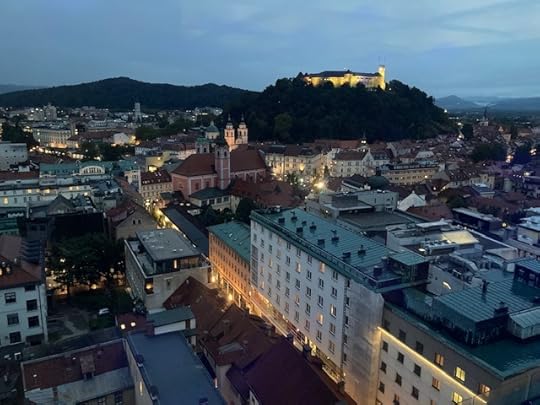
The pink façade of the 17th century Church of the Annunciation dominates the central square in Ljubljana and it was here the next morning that we joined our walking tour guide to learn more about our surroundings. Lena, not her real name, revealed the most fascinating personal backstory, which underlined my first impression of Ljubljana as a charming, safe, citizen-focused capital city. Lena told us she was born in Ljubljana and had only recently returned to her homeland from London, where she had been a social worker for several years. The stress of the job and with the needs of her own young child to consider she made the decision to follow her desire for cleaner air, improved mental and physical health and a more sustainable lifestyle. She proudly told us that Ljubljana ticked all her boxes and she now earns her living by explaining her passion for the city to visitors. The happiness she derives from being able to do this daily was tangible. The city couldn’t have a better or more enthusiastic ambassador.
Ljubljana’s wholesome atmosphere has a lot to do with visionary architect Jože Plečnik. His distinctive bridges, buildings and landscaping were designed as part of an urban planning scheme in the 1920s to turn the capital into a pedestrianised, sociable and sustainable city, long before such concepts were widely talked about. If the mission of architecture is to achieve immortality, Plečnik has surely lived up to his own philosophy. He designed the iconic central market area where a host of artisan producers and local growers still set up daily and the magnificent National and University Library building, said by the architect to be Slovenia’s ‘temple of knowledge and wisdom.’
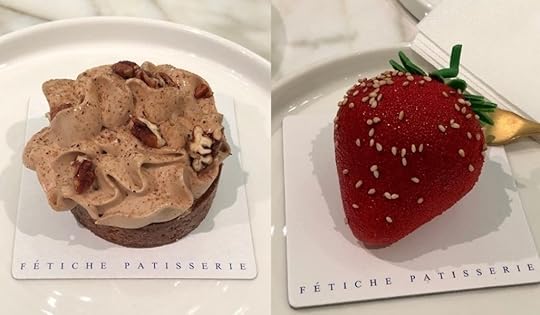
In the same street where we sampled free samples of locally made fig and plum liqueur, we spotted a window of elegant edible creations that had to be sampled. The originality of the fruit and chocolate-inspired goods at Fétiche Patisserie tasted even better than they looked. On the second visit, the creator, a young, somewhat dishevelled young man, was leaving for the day. A true artist. He certainly looked the part.
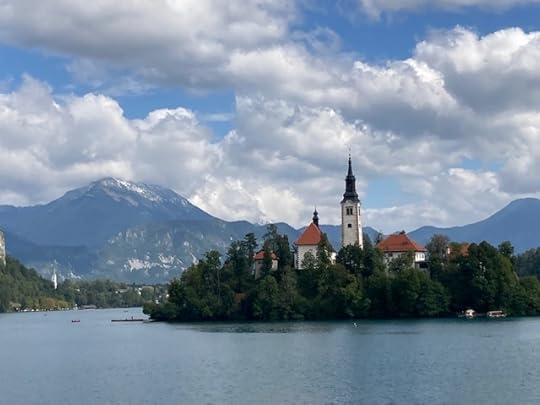
Slovenia is a country of stunning outdoor locations so it would have been unthinkable to leave without a day trip to one of the most popular nearby locations. Just over an hour’s bus ride away lies Bled, with its gorgeous lakeside walk. Luckily, we had a sunny day to enjoy the beautiful views.

October 14, 2024
Trieste – the blended city
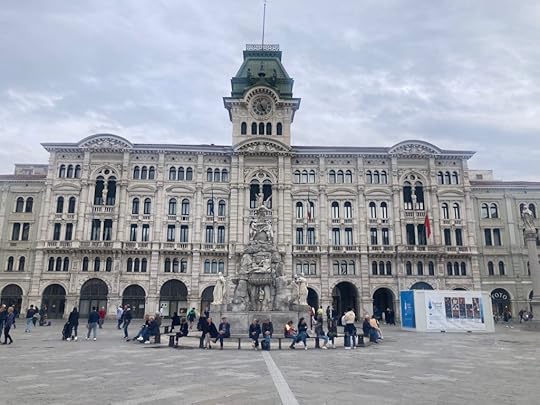
Travelling northeast by train from Venice we find ourselves in the seaport of Trieste, close to the border with Slovenia. Proudly Italian I’m told, but a little more complicated in identity as it has only been the capital city of the Friuli Venezia Giulia region since 1963. Before that it was part of Austrian territory for centuries and since the First World War territorial changes and disputes have left their mark with a diverse population influencing the culture and the food.
In stark contrast after Moorish Venice, Trieste boasts elegant Hapsburg era architecture on a grand scale with wide streets and an enormous central square with a sea view. The Hapsburgs don’t have it all their own way, though. A medieval old town and the remains of a Roman theatre are just a short walk from the centre. Trieste even has its own Grand Canal in the centre of the city and though wide, this is almost decorative by comparison to the major waterway of the same name in Venice.
Confetti and Coffee
Trieste is famous for a few things, and you don’t have to be here long to know what they are because the Triestini will soon tell you. Apparently, the tradition of throwing paper confetti over newlyweds and at other celebrations began in Trieste in the 1800s, when a teenager named Ettore Fenderl couldn’t afford the expense of showering the passing carnival parade in rose petals and improvised with small pieces of coloured paper. This smart young man went on to become a celebrated scientist, inventor, and philanthropist. It may be that it took the Milanese engineer Enrico Mangilli to experiment in a similar way, and then commercialise the idea but you won’t hear too much about that version of events in Trieste.
The illy coffee brand has its head office in the city and the claim that this makes Trieste the coffee capital of Italy is not just marketing guff. The Mediterranean’s biggest coffee port started to grow under Austro-Hungarian rule and spawned the café culture reminiscent of Vienna and Budapest that remains today. In 1933, Hungarian born Francesco Illy established the family business and went on to invent the first automatic coffee machine and novel systems of packaging that meant he could sell his brand across Italy and eventually, the world. Research and innovation is still the hallmark of the illy family business. With this impressive heritage Trieste has developed its own language for ordering coffee, quite different from the rest of Italy and Europe and with many more variations concerning the quantity of the milk and whether the receptacle is a glass or a cup. We comprehensively failed to master all this in a couple of days. For example, a cappuccino is called a caffelatte, an espresso, a nero. We ordered with confidence and in total ignorance every time and mainly got something we weren’t expecting but you live and learn.

The best thing about Trieste’s coffee culture is of course the accompanying sweet treats available at the many Viennese-style cafés. Close to our accommodation and popular with families on a Sunday morning, La Bomboniera is one of the city’s finest Austro-Hungarian style patisseries. Founded in 1836 and offering such a superb choice of cakes, pastries, and chocolates there is hardly any room for seating, we had to brave the chilly temperature and eat at a table outside like the locals but it was well worth it.
Trieste has a less welcoming face in the winter, due to the ever-present possibility of the notorious Bora wind. Severe gusts of up to 150km can be so challenging that handrails have been installed in strategic parts of the city to assist pedestrians in danger of being knocked off their feet!
Food and Fashion
Whilst standard Italian food is easily available it is really interesting to note how history has influenced the food culture in Trieste with dishes like goulash and Piatto Misto di Caldaia – a mixed plate of different cuts of boiled pork, with sauerkraut and horseradish typical examples. For the best goulash, Al Petes a superb restaurant in the old town serves a meltingly tender beef cheek version. I should add that prior to goulash we had enjoyed the most amazing amuse bouche. The purpose of these little bites is to whet your appetite for what is to come but this little square of venison lasagne, oozing with meaty ragu and cheese sauce left me wondering why this wasn’t promoted to a main course.
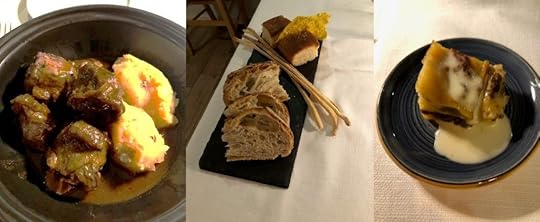
Trieste continues to be open to different world cuisines and has elevated international street food to glorious heights with a row of popular gourmet food trucks positioned near the Grand Canal. The aromas from the Serbian, Turkish and Greek stalls were tempting but there was no contest really. Argentinian beef rib, roasting en masse on giant vertical grills and cut to order was our very fine Sunday lunch, eaten Trieste -style with chips, on nearby bench seating, and washed down with a cold beer. People talk fondly about the past, but did anything taste this good when James Joyce walked these streets?
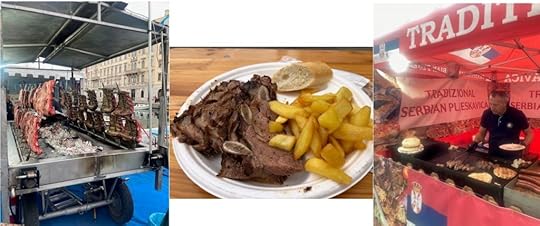
Turn of the century cafés where intellectuals from across Europe would meet to exchange ideas would have been familiar to James Joyce. He spent ten years in the city from 1904, famously living above a brothel in the former Jewish ghetto. A prominently placed bronze statue of the writer celebrates his links with the city. There’s also a James Joyce museum to get the full story but we declined this in favour of a much more exciting offer at the ITS Arcademy Museum of Art in Fashion. Italy’s first museum of contemporary fashion is a must visit for anyone with a passing interest in the relationship we have with clothes. I particularly enjoyed the thought-provoking and poetic observations on clothing. ‘A wardrobe is first and foremost a small domestic museum. Folded and stacked up, hanging on the metal shoulders of hangers, clothes are negatives of ourselves, waiting to be seen.’
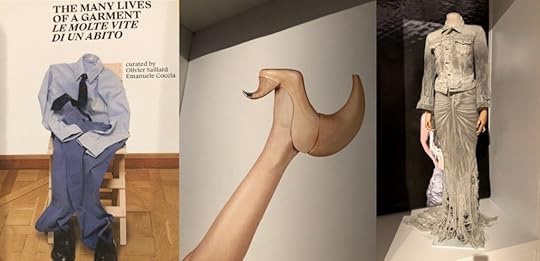
As well as beautifully designed exhibitions and an archive, the museum runs an annual competition for emerging designers. From over 750 worldwide submissions, a handful of finalists are invited to display their creations. Visitors can also leaf through their individual digital portfolios to better understand and appreciate the creative minds behind the ideas.
Shame and Beauty
The Nazi era casts a long shadow over most European cites and Trieste is no exception. The synagogue of Trieste was inaugurated in 1912 and is among the largest in Europe. Our guide told us it survived wartime devastation as the Nazis planned to turn the building into a luxurious swimming pool. Meanwhile, just a bus ride away, the Risiera di San Sabba, now a museum and national monument, was used from 1943 as a place of detention and murder. The crematorium installed on the site from 1944 was destroyed by the Nazis before they fled.
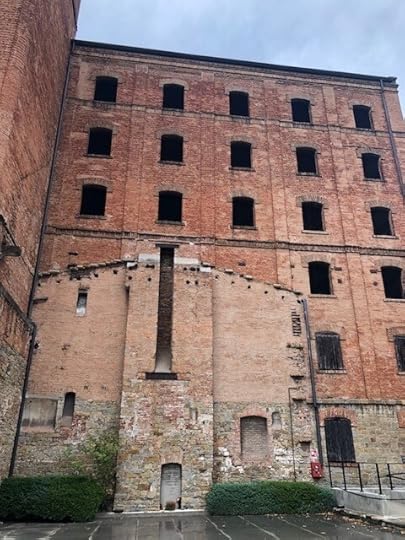
The weather was very changeable in the three days were spent in Trieste but we took advantage of a sunny day to take a boat trip from Trieste to Castello di Miramare. The gothic, white stone castle is a former residence of the Hapsburg family. We decided not to tour the interiors but instead explored the grounds and the beautiful botanical gardens.

Next stop, Ljubljana, Slovenia.
October 4, 2024
Hungry for more – what we ate in Venice
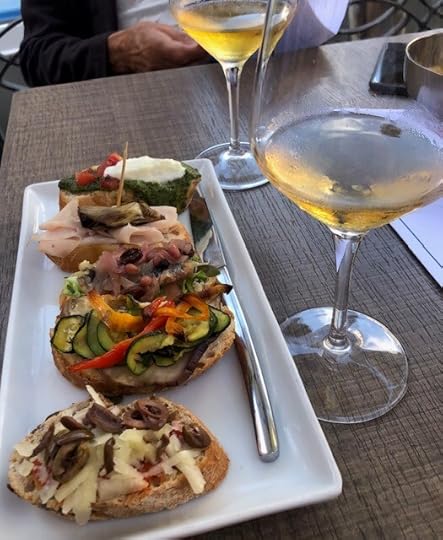
It’s an unfortunate truth but in a city literally overflowing with water, tourists, and restaurants it can be difficult to find that genuinely authentic Venetian eating experience. The places you hear about, where the gondoliers allegedly eat, are the stuff of legend. I’ve been to Venice about 20 times and I’ve yet to stumble upon tables of lads in striped tops, chewing the fat over their lunch. Truth be told they don’t want to be found. The last thing they need is a pair of Brits interrupting their downtime with awkward questions about whether the risotto features squid ink. Venice likes to keep tourists where they think they really belong and that’s why the pizza and pasta restaurants, especially those with a romantic canal side setting, are always busy.
It’s a familiar scenario. You’re hungry and on your way somewhere else when you walk past tables of diners enjoying delicious looking plates of familiar fare. There’s a free table in a great spot and you’ve already forgotten about going anywhere else because the smell of the pizza oven is irresistible. It’s great pizza. Terrific pasta but somehow, not completely satisfying because you can eat it anywhere. Venice doesn’t give up its more interesting dining secrets easily and the adventurous eater needs some determination to unearth them.
This endeavour has become a little easier since several TV chefs have made a career out of highlighting some of the previously little known authentic Venetian restaurants. One restaurant in particular, Antiche Carampane, attracts so many visitors through this kind of publicity it actually has a notice in the window warning hapless tourists, ‘No Pizza, No Lasagne, No Tourist Menu.’ It was pointed out to me quite aggressively when I first made a booking.
I spent many years studying Italian at evening classes, principally so I could eat my way round Italy with some knowledge of the language and culture. Venice is the only city where all my efforts have proved useless. For very understandable reasons, I’ve come to believe the Venetians cannot bear to hear anyone mangling their beautiful language. Whenever I dare to open my mouth, the reply is usually in perfect English which is a real knock to the budding linguist’s confidence and dispels any illusions I might have that my glaringly obvious tourist status is invisible. Not a hope. So, the idea that I could ever walk into a bar full of locals and order my cicchetti of choice, like they do, just seemed too intimidating to even contemplate. However, through prior research on YouTube and some assistance from Venetian nobility I made a breakthrough on this trip.
Cicchetti, pronounced (chi-ket-tee) are the tastiest of Venetian snacks, eaten at any time of the day and usually enjoyed with a glass of wine or the ubiquitous Aperol spritz. Some liken them to tapas, but this is inaccurate. Not all tapas is finger food. The important thing about cicchetti is that they can be picked up and eaten – the most common are small rounds of toasted bread, generously loaded with a meat, seafood, vegetable, or cheese-based topping. Seasoned and oiled, fragrant with herbs, the best of these appear so simple but leave you wondering how they pack so much flavour into every morsel. Deep fried meat or rice balls, even little open topped savoury pies can also be offered, depending on the speciality and imagination of the particular bar.
That I know this is entirely down to the TV presenter and historian Francesco da Mosto. Count da Mosto’s programmes on Venice are often filmed in and around the family’s Renaissance palazzo, where centuries before his distinguished ancestors made their mark as merchants and explorers. Interestingly, the fearless British chef Rick Stein relied on Francesco’s superior knowledge for his own programme on Venetian delicacies and it was an extract from this on YouTube that proved so informative on cicchetti.

In the programme Francesco takes Rick to his local bar, All’Arco, one of the most famous in Venice. On a previous trip I recall being taken there for a pre-dinner snack by a knowledgeable friend but either I wasn’t paying enough attention, or she helpfully chose for us, so I didn’t see the options. Needless to say, when we went back this time, we unwittingly turned up on a day All’Arco was closed and the next day the queue to get in was too long. Undeterred we scouted out the nearby competition and the eating experience at IL Sigillo was so good we went back twice, although at 11am it was tea we wanted with our snacks rather than wine. The proprietor was exactly as you would expect. Round, jolly, heavily moustached and overseeing a window full of mouth-watering, freshly made cicchetti. He had the radio up at full volume and was also singing along so any attempt at language was rendered pointless. Sign language sufficed. Our sharing plate was warmed under the grill and carefully portioned so we both had a taste of spicy salami, creamy mozzarella, juicy aubergine, salty prosciutto, and peppery olive oil. A very satisfying late breakfast.
The Venetian lagoon and the famous Rialto fish market ensure super fresh seafood is a staple of the local cuisine, but two specialities famously feature preserved fish, a hangover from ancient times when sailors on long expeditions relied on the ability to treat fish with salt or vinegar to keep it wholesome. Baccalà mantecato, widely available where cicchetti are served, is salted poached cod, whipped with olive oil to a creamy spread and piled onto grilled bread or toasted polenta. Utterly delicious. Another Venetian signature dish is Sarde in Saor a sweet/sourcombination of sardine fillets, onions, pine nuts, raisins, and vinegar. We tried both of these at the high end Pensione Wildner, close to the San Zaccaria vaporetto stop, where they serve their sardines with sauerkraut and the prices reflect the heritage and location. It was well worth it for this and the traditional Spaghetti alle Vongole e Bottarga (spaghetti with clams and seasoned with mullet roe).
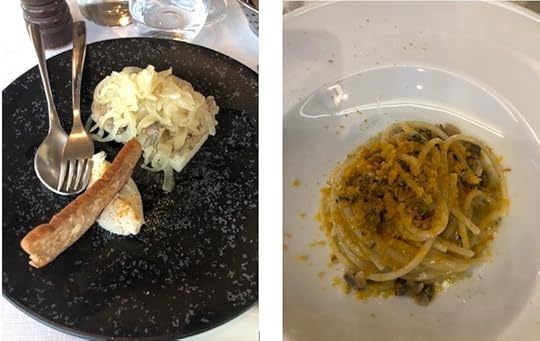
My guidebooks on Venice are stuffed full of business cards and receipts from previous visits to places we might want to return to. It’s fun to see if they are as good as we remember or even if we can find them again, so I usually bring them with me. The first time we went to Trattoria da Fiore we sat at high stools at the open window, watching the daytime crowds walk by. It was hot. We would have had a glass of wine, but I don’t recall what we ate. Perhaps we didn’t eat at all, but I kept the card all the same and this time around we fancy dinner. There is a table for two at the back of the restaurant next to a young Italian couple. As soon as I see the menu I relax, secure in my choice. They will know how to make this for sure. Fegato alla Veneziana. It’s one of the finest dishes in the Venetian repertoire. The best calves liver, trimmed and cut into small slices, combined with buttery sweet, caramelised onions and served in a rich wine and vinegar sauce. This version is sweeter still as it includes green figs in the sauce. They must have known I was coming. This dish is often served with polenta. I don’t care for polenta and would have left it on the plate but luckily this comes with mashed potato to soak up all the velvety sauce. It’s heavenly. I glance across and see the young Italian couple have ordered the same as me. They look pretty happy too.

Bacarando is one of those places that it would be hard to stumble upon. You have to know it is at the end of a very unpromising alley. We only know where it is because several years ago we rented an apartment that almost backs onto it and probably a folder of information on this and other local restaurants was provided by the owner. Back then we ate al fresco in a little courtyard, unaware that inside, at the bar, the most amazing selection of cicchetti is rightly the main attraction. Deep filled open pies are the speciality of the house and the display is exceptional. We didn’t want to spoil our appetite for dinner, so we chose one to share between us with prawns and a pea puree. How we chose I don’t know. They all looked amazing. It was pouring down outside, and our little pie was packed in a takeaway bag. We found some shelter and tucked in. Oh my. Underneath the abundant topping were thin layers of seasoned, buttery potato, all held in place within a crisp pastry case. The prawns, the peas and the potato were just the best versions of themselves you can imagine, and it wasn’t measly. It was small but abundant! It was one of the best food experiences I have ever had – dripping wet and eaten in shared bites from a paper bag! We concluded we should have had one each. To misquote The Talented Mr Ripley, see Venice and pie. Next time. For now, onwards to Trieste.
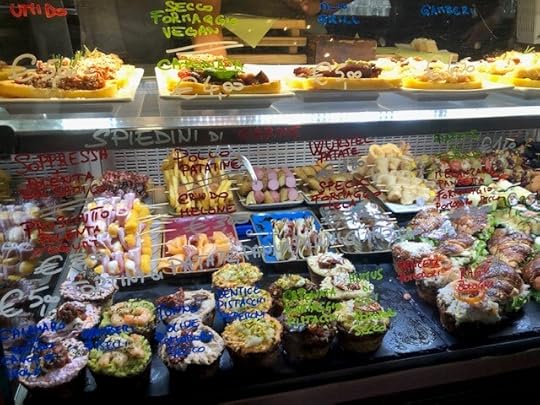
September 25, 2024
Foreigners Everywhere Part 1
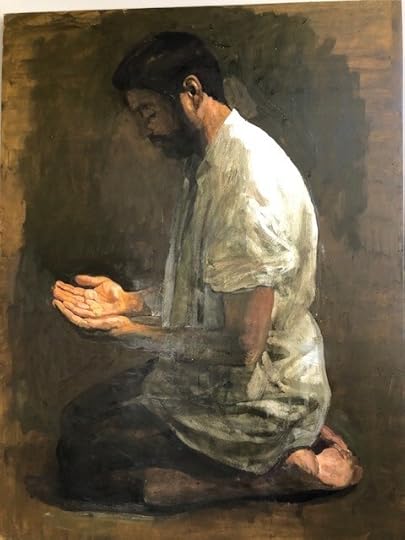
The 60th International Art Exhibition, Venice 2024
We have been coming to Venice regularly since the early 2000s when our eldest son was a fine art student and could enthusiastically talk us through the merits of some of the more obscure submissions on show at the biennial international contemporary art exhibition. We were instantly hooked and have returned many times to repeat the experience but latterly without our knowledgeable guide in tow.
The two main venues for the show are terrific – one a fabulous garden, (Giardini) with 30 national pavilions, the second, a complex of historical shipyards and armouries (Arsenale), formerly the powerhouse of Venetian naval power and now transformed into a multitude of gallery spaces. In addition, there are usually a substantial number of free art shows dotted around the city in churches, palaces, workshop spaces down unlikely narrow alleys and one year, famously above a supermarket. For a perfect experience all you need is good weather, a ticket that permits entry to the two main venues over consecutive days and an inclination to mooch. The art and how it speaks to you ultimately determines the pace.
I always look forward to discovering my personal wows but accept there will be much that leaves me cold. Don’t like what’s on show at this pavilion? Move on. Hopefully, the sun is shining and you’re in Venice is my attitude and it’s best not to take it all too seriously. There are always laughs to be had, even if the artist doesn’t intend them. One year I recall watching a two-hour video in which the artist, Mark Wallinger roams the lobby of a gallery at night dressed in a bear suit. It was riveting and ludicrous. Once upon a time these antics would have been regarded as avant-garde. Now, a bit old hat.
Potent Global Theme
The exhibition always has an overarching theme and in past years has been so open to interpretation as to be virtually meaningless. The Milk of Dreams, May You Live in Interesting Times and Think with your Senses, Feel with your Mind are recent examples. I only learned this year that the artists are not obliged to adhere to the given theme, but this year’s provocative choice of Foreigners Everywhere (Stranieri Ovunque), not only resonated with me as a visitor to the exhibition, but also in the city and seaport of Trieste and even on our route towards the Slovenian capital, Ljubljana.
Who are the foreigners? For a living, breathing, but fragile, visitor attraction like Venice, that’s just about everyone, most of the time. Born and bred Venetians are an increasingly rare breed with Chinese property investment plus tourism creating a two-headed beast. The tax revenue to the city might be welcome but the impact vast visitor numbers inevitably have on the lagoon environment remains a concern. Hence the move to ban the cruise ships and their populations of day trippers from Venice. Now, they dock and discharge their human cargo in Trieste which is probably better suited to such an onslaught.
Artistic statements alluding to the movement of people, borders, integration, invasion, occupation, alienation, prejudice, war, colonialism, nationalism, and identity are always well represented with the emphasis reflecting the zeitgeist. This time, gender fluidity or maybe confusion, is well to the fore and celebrated in sculpture, painting, and a few self-indulgent films and if that’s your thing there is plenty of it.
More pertinent to my mind is the artwork that made me consider how we view migrants and refugees who leave their homeland, for whatever reason, in search of the kind of life they think we live. We never consider what it’s like for them to journey through unknown countries and across many borders when everyone they encounter is a foreigner to them! I am thinking particularly of the groups of listless young men I saw gathered in the park opposite Trieste railway station, some with back packs, others with bin liners of possessions at their feet. Waiting for their lives to begin but invisible to passers-by. Or a similar group, static and silent on the steps of Postojna train station in Slovenia. The town has a notorious detention centre for asylum seekers entering the country from Croatia and Bosnia, via the so-called Balkan route. Do they feel disappointed? Disillusioned? Regretful? Lonely?
The Mapping Journey Project by Moroccan artist Bouchra Khalili captures untold refugee stories in stark visual language. An installation of eight giant screens show maps of different parts of the world and a hand, marking in black pen, endless, illegal journeys across many borders leading to Europe. Their words chart difficult, convoluted routes and the risks taken to fulfil basic human needs. It’s hard to walk away and the straightforward presentation makes this, for me, far more powerful than the verbose text that accompanies too many of the submissions. If you have to go to great lengths to explain your artistic concept so visitors ‘get it’ then maybe rethink your concept.
A playful, upholstered tunnel forms the centrepiece of Eva Kotatkova’s artwork for the Czech pavilion and is intriguing, yet impressively clear on the wider questions it poses on the culture of plucking animals from their natural habitat to keep them in captivity. The heart of a giraffe in captivity is twelve kilos lighter tells the story of Lenka, a giraffe captured in Kenya for Prague Zoo in 1954, where she died just two years later.

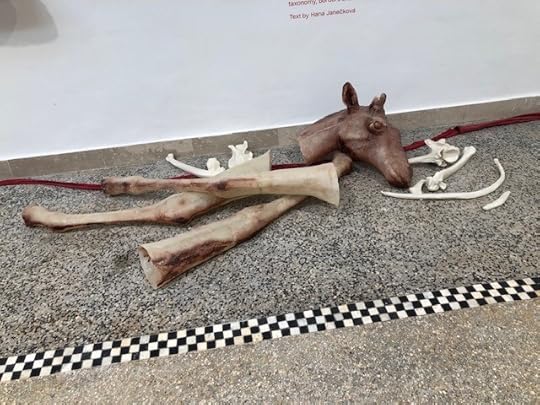
Real World Realities
As two years ago and with the invasion of Ukraine still ongoing, the Russian Federation’s pavilion in the Giardini remains firmly closed whilst a collective of Ukrainian artists at both venues are defiantly present. Repeat After Me II, in the Polish pavilion features a video demonstration by Ukrainian refugees imitating the sounds of Russian mortar shelling and aerial bombardment. Visitors are invited to join in, karaoke-style. I wonder if anyone ever does.
In past years Israel has been the standout highlight for me with absorbing shows that succeeded in making artistic statements in novel ways. For example, in 2019, the entire Israeli pavilion was transformed into a field hospital, with visitors cleverly processed through the exhibition, first as patients, and then as listeners to stories of injustice. Forward to 2024 and armed guards keep a watchful eye for protesters as visitors read a notice announcing Israel’s exhibition will remain closed until a ceasefire and hostage release agreement is reached in Gaza. Whilst the sentiment is noble I can’t help feeling that presenting a closed door to a global audience is a wasted opportunity.
Lasting Impressions
The Japanese pavilion can be usually relied on for quirkiness and this year’s presentation didn’t disappoint. Sculptor Yuko Mohr unusually built her array of Heath Robinson-style ‘machines’ onsite, with materials and objects sourced from the local area. The awkward movement of water through the various bits of piping and other discarded items is the catalyst for tinkling chimes. Hardly unique. More peculiar was the pervading smell from displays of decomposing fruit. These wrinkled items are stabbed with electrodes to convert the moisture they contain into electric signals, creating an intermittent sound and flickering light. It was certainly a full-on sensory experience.
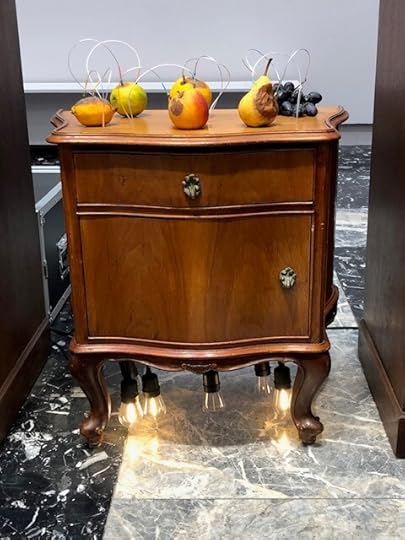
The Korean pavilion took this idea even further with an exploration of how scents, smells and odours are linked to memories, culminating in an arresting bronze baby, discharging a sickly milky smell from its nostrils every two minutes. Make it stop was my honest response.
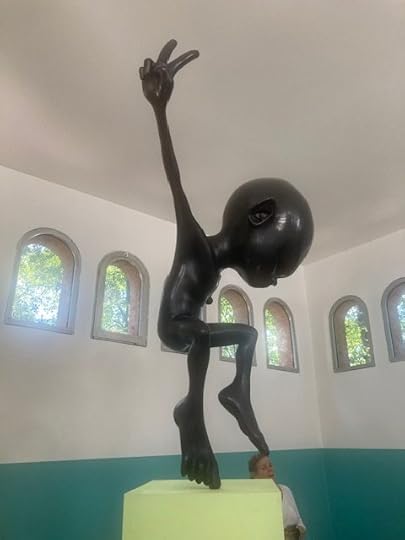
For sheer impact through colour, texture and size, Jeffrey Gibson’s paintings and sculpture on show outside the American pavilion are a magnetic draw. Inside, the vibrant patterns and gorgeous beaded figures call to mind the artist’s first nation ancestry. No doubt the artist has more lofty thoughts on his own work but sometimes, aesthetics are all that matters.

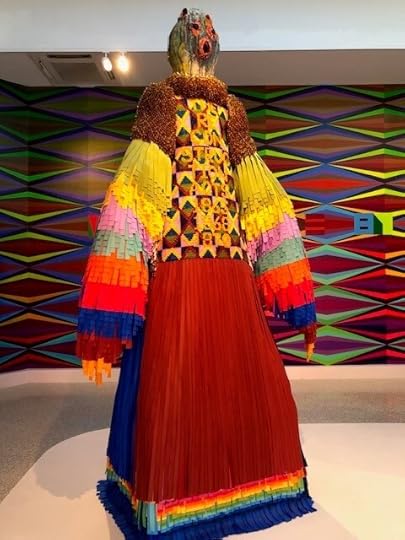
Safet Zec’s astounding figurative paintings in the Venice pavilion are breathtaking. Perfectly aligned with the theme, his moving images reflect exodus and heartbreak based on his own experience. He says, “I would like to recall that I was a refugee, a man who had to leave the country he loved, the country where he was born, lived, educated, and studied… a country torn apart by war and nationalism. In the former Yugoslavia I was established and had acquired a prestigious position in the world of painting, which I now also enjoy in Venice, my beloved adopted city.”
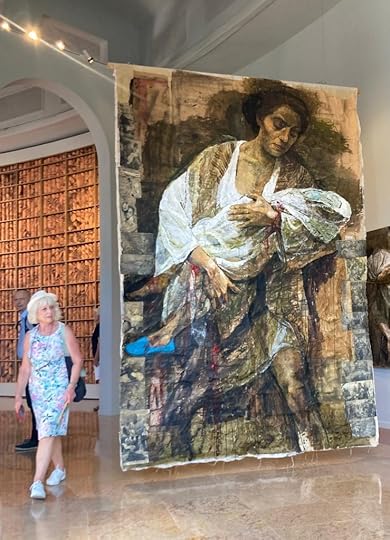
Bravo Safet Zec. For me, the star of the show. Thought-provoking contemporary art needs a new movement. Let it start with beauty.
The 60th International Art Exhibition continues in Venice to Sunday, 24th November 2024
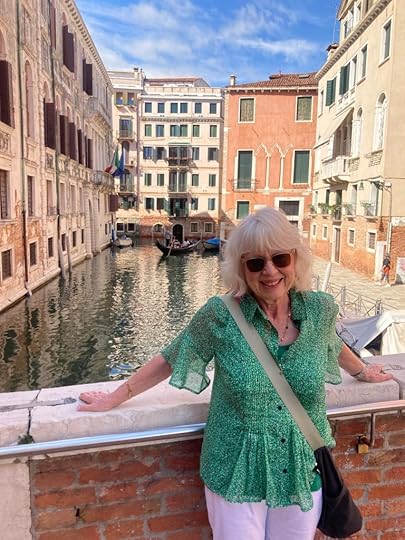
December 26, 2021
Lockdown inspires author’s ‘bite-sized’ travel memoir
Suffolk Free Press, published 23 December 2021
Bite-sized World available in paperback and ebook https://amzn.to/33KpEDH
November 25, 2021
Bite-sized World
Travel, eating out and live entertainment – the activities that enrich our lives – are celebrated in this entertaining, but unexpectedly nostalgic memoir of recent times.
From adjusting to expat life in Dubai, to accounts of visits to eye-opening destinations around the world, including, Iran, Georgia, Lebanon and Jordan, the author’s revealing snapshots recall the world before a global pandemic confiscated the freedoms we previously took for granted.
Ever hopeful, the author’s enthusiasm for exploring new places, eating great food and attending the next Bruce Springsteen concert remains undiminished.
Join Ruth Badley as she explores Jordan’s legendary Rose City and Kiev’s fabulously eccentric toilet museum. Sample street food in Singapore, curry in Kerala and performance art in Hobart. From a theatrical world premiere in the Middle East, to rock music in Manchester and a weird encounter on a Polish train, these illuminating vignettes date from 2015 to 2021. Find Bite-sized World here
Bite-sized World is Ruth Badley’s second full length book and follows the award-winning success of Where are the grown-ups? The true story examines the impact of a domestic tragedy on three generations of the author’s family.
If you enjoy Ruth Badley’s books, please leave a review on Amazon and Goodreads. Reviews helps others readers find the books they want to read.



